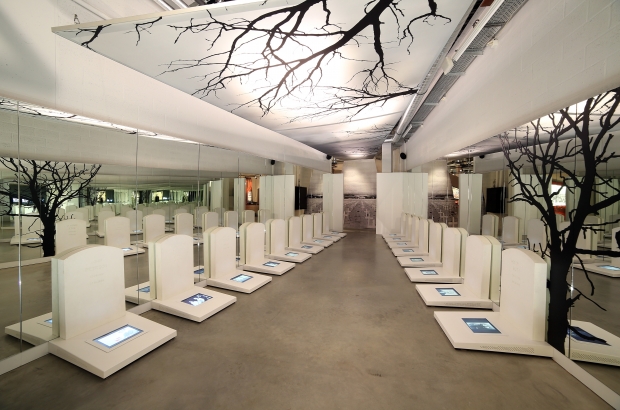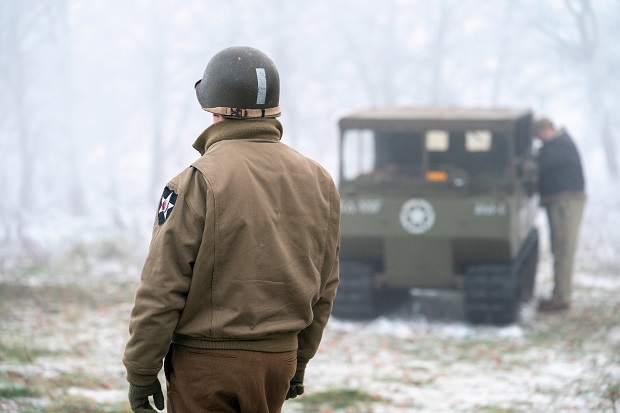- Daily & Weekly newsletters
- Buy & download The Bulletin
- Comment on our articles
Bastogne commemorates 80th anniversary of the Battle of the Bulge
US flags are flying from every street of Bastogne this weekend as the Ardennes town commemorates the 80th anniversary of the WWII Battle of the Bulge.
A special programme from 13 to 15 December honours the sacrifice of soldiers and civilians during the final major offensive by Nazi Germany. The six week conflict during the bitter winter of 1944-45 resulted in catastrophic losses on both sides while paving the way for the Allies’ victory in Europe.
King Philippe and Queen Mathilde of Belgium will be joining veterans and national and international dignitaries for a series of memorial ceremonies on 14 December.

In what is likely to be last large-scale commemoration of World War Two in Belgium with living veterans in attendance, Bastogne is determined to mark the landmark anniversary with a collective homage to the fallen, both military and civilian.
Each year in mid-December, the town stages a Nuts! weekend in honour of Brigadier General Anthony Clement ‘Nuts’ McAuliffe’s famous retort at a critical stage of the offensive.
As the US army’s 101st Airborne Division lay besieged, the Germans asked the general to surrender or be annihilated by massed artillery. His caustic response, “Nuts!”, completely stumped them.

The McAuliffe monument is just one of the sites where the Belgian royal couple will participate in a wreath laying ceremony before heading to the town hall to meet veterans and then join in the traditional nut-throwing ceremony from the balcony.
This symbolic moment will be followed by a patriotic parade through the town centre and the laying of flowers at the memorial to General Patton, who also played a key role in defeating the German counterattack.
Alongside the official ceremonies, Bastogne – now a major memorial tourism hub – is staging re-enactments, parades of military vehicles, meet-and-greets with veterans, exhibitions, concerts and a spectacular sound and light show at the Mardasson Memorial.
Here’s some of the highlights of the commemorative programme in Bastogne. Events are also staged in other towns and villages that also suffered in the Battle of the Ardennes, notably La Roche-en-Ardenne, Malmedy, Houffalize, Manhay, Celles, Stoumont and Saint-Vith.

The important commemorative site lies on the outskirts of the Ardennes town, alongside the Mardasson Memorial that honours fallen and injured US soldiers. The museum itself is a lively and interactive presentation of the final large-scale offensive that also offers a modern contextualisation of WWII.
Since its opening in 2014 ahead of the 70th anniversary of the battle, the museum has succeeded in attracting 150,000 visitors a year.
During the 80th anniversary weekend, visitors can hear live testimonies of American and Belgian veterans and participate in book signings with actors from TV series’ Band of Brothers and Masters of the Air. Outside, a US-style military camp is set up with re-enactors and vehicles from the war era.
Mardasson Memorial

Overlooking the town of Bastogne, and adjacent to the war museum, this landmark monument is dedicated to the battle’s 76,890 fallen US soldiers. Built in 1950, the memorial in the form of a star with five points symbolises the indelible alliance between the US and Belgium following the shared battle experience. Engraved on its interior walls are the names of the American states and battle units that fought. Underneath the imposing structure is a crypt decorated with an ornate mosaic by the modernist French artist Fernand Léger.
This is the site of Luc Petit's sound and light show Texas Aggies: into the Battlefield on 14 December, from 18.30 to 21.00. The world-famous Belgian artistic director has created an immersive spectacle with some 100 artists. It includes video-mapping of the memorial and grandiose pyrotechnic special effects. The show commemorates the bloody battle by recounting the fate of five young Texans plunged into the hell of the winter battle.
If weather permits on 15 December, parachute drops will be made on the memorial as well as a flypast of vintage fighter planes.

The cellars of the military barracks where the mythical ‘Nuts’ episode took place have been transformed into a modern interpretation centre that opened in February 2024. It takes visitors on an immersive and interactive journey into the battle via educational and interactive exhibits. The basement complex has been carefully preserved to retain its authenticity and atmosphere.
On 14 and 15 December, from 9.00 to 21.00, the site hosts the re-enactment of a military camp, a secret service post and recreates the Allies’ HQ in the basement.

This weekend is an opportunity for the public to discover the Vehicle Restoration Centre’s collection of tanks and other armoured vehicles, including famed steel giants such as the Sherman Jumbo Cobra King and the Russian JS-3 tank.
The barracks is also showing off a Tiger II, a 70-tonne German tank loaned by the Armoured Museum of Saumur in France. It’s the first time the most powerful tank of WWII has been driven in Bastogne since January 1945.

Hitler was rolling the dice one last time when he planned the massive attack on the pivotal town of Bastogne, close to the Luxembourg border. Under pressure from west and east, it was a desperate attempt to split Allied lines, secure the strategic port of Antwerp and force a negotiated peace.
Heavily reliant on the element of surprise, it was carefully timed to take advantage of the bitter cold, freezing rain and deep snow drifts, knowing that the US were ill-prepared for such conditions. He also gambled on the weather preventing Allied aircraft dropping supplies.
The German army was initially successful, outnumbering the Allied forces in the Ardennes, all either new recruits or battle fatigued. After the first assault at dawn on 16 December 1944, German forces carried out massacres in the nearby town of Malmedy before surrounding Bastogne. The town was under siege, its citizens taking refuge in any underground space they could find along with some 16,000 soldiers of the 101st Airborne Division.

Then St Vith fell, the day before the fateful communication to McAuliffe and his provocative, morale-boosting response. On 23 December, the US began their counterattack, aided by the weather clearing sufficiently for aircraft to deliver provisions via parachute. The arrival of General Patton and his tanks and infantrymen on 26 December succeeded in breaching the German’s stranglehold of Bastogne.
Despite the decisive victory, fighting continued. It wasn’t until 25 January that the Allies finally triumphed and could advance into Germany on route to Berlin. But the bitter six-week battle resulted in heavy losses. The final tally was around 75,000 American, 1,400 British, and 100,000 German casualties. Some 3,000 local people lost their lives.
For British prime minister Winston Churchill, the Battle of the Bulge was “undoubtedly the greatest American battle of the war”.
Photos: Bastogne sign ©US Army NARA; town of Bastogne; General McAuliffe decorated by General Patton ©US Army Nara; Bastogne War Museum; Mardasson Memorial ©Bastogne War Museum; Bastogne War Rooms ©Tempora; Bastogne Barracks; Nuts Weekend ©Tempora

















